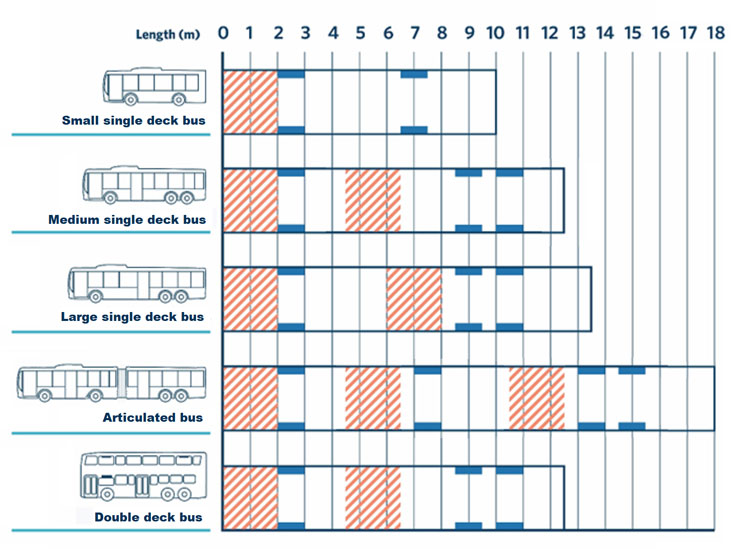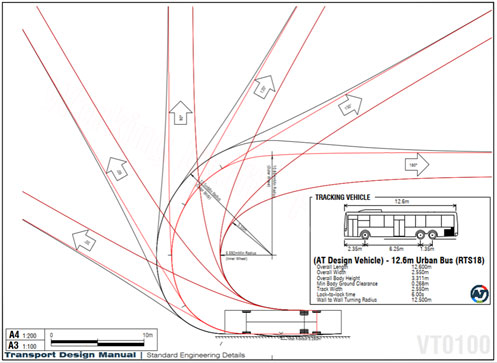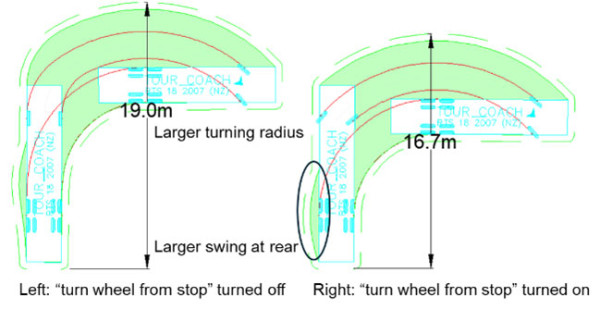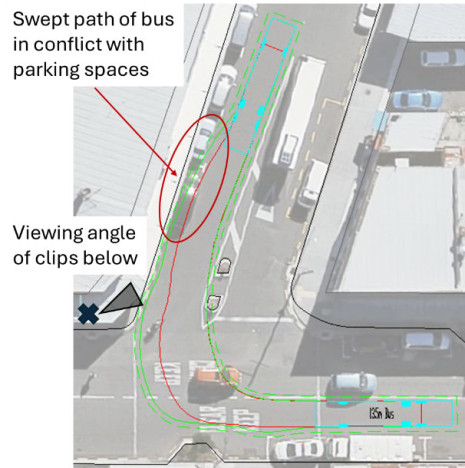|
This is draft guidance, and we welcome your feedback |
This topic discusses the critical dimensions and performance characteristics of buses which typically operate in New Zealand. It also provides advice on undertaking swept-path and tracking analysis for buses.
You can also download a printable copy of this topic:
Bus dimensions and tracking [PDF, 808 KB]
Bus dimensions vary by bus type, but all buses operating in New Zealand must comply with the Vehicle Dimensions and Mass Rule 2016 and any approved exemptions.
Land Transport Rule: Vehicle Dimensions and Mass 2016
Additionally, all urban buses must comply with the vehicle standards contained in the Requirement for urban buses in New Zealand, unless a variation has been sought and approved from NZ Transport Agency Waka Kotahi (NZTA).
Requirement for urban buses in New Zealand
The design vehicle is the largest vehicle expected to operate regularly in a specific location or route. However, it may not be the largest vehicle that could operate there. Design vehicles must remain within their traffic lane, and where lanes are not marked, they must allow for adequate clearance with the design vehicle in the opposing direction.
The 'Check Vehicle' concept is intended to accommodate larger vehicles that may need to operate in a specific location or route from time to time. Check vehicles can use reduced clearances. At intersections, check vehicles may encroach into adjacent lanes in the same direction, but not opposing traffic lanes, except on a minor or terminating road. While this may inconvenience some road users, the infrequent occurrence of these vehicles makes this acceptable.
The dimensions for the various types of buses are provided in Table 1.
The features below need to be considered when determining the amount of space required for the design of public transport facilities:
*Unless a variation has been sought and approved from Waka Kotahi NZ Transport Agency.
It is expected that public transport facilities are designed to accommodate the ‘standard’ vehicle dimensions, including the provision of a bicycle rack to account for future proofing.
Note that the Vehicle Dimensions and Mass Rule and the Requirement for urban buses take precedence over the dimensions contained in the table below if there are any discrepancies.
It is recommended that designers confirm the current and future public transport fleet characteristics early in the design process. There are certain bus vehicle types such as coaches, where the designer may need to consider a ‘non-standard’ design. It is recommended that the designer source further vehicle dimension information specific to these ‘non-standard’ vehicles from the relevant manufacturers prior to commencing any infrastructure design work.
Within this guidance, unless indicated otherwise, the key parameters provided in Table 1 are based on the ‘standard’ dimensions for single-deck and double-deck buses.
Table 1: Vehicle characteristics and dimensions
|
Vehicle characteristics |
‘Standard’ bus indicative dimensions |
||||
|
Small single deck bus |
Medium single deck bus |
Large single deck bus, rear-steer |
Articulated bus |
Double deck bus |
|
|
Length – vehicle only |
10.1m |
12.6m |
13.5m |
18.0m |
12.5m |
|
Length – vehicle with deployed bicycle rack[1] |
11.1m |
13.6m |
14.5m |
19.0m |
13.5m |
|
Width (including mirrors) |
2.98m |
2.98m |
2.98m |
2.98m |
2.98m |
|
Height |
3.4m |
3.4m |
3.4m |
3.4m |
4.3m |
|
Front overhang |
2.5m |
2.35m |
2.7m |
2.7m |
2.5m |
|
Rear overhang |
2.5m |
2.65m |
3.0m |
2.85m |
2.5m |
|
Wheelbase |
5.1m |
6.9m |
7.0m |
5.65m (front) 6.80m (rear) |
6.8m |
|
Ground clearance |
260mm |
270mm |
330mm |
260mm |
305mm |
|
Front door height - kneeling |
245-280mm |
245-280mm |
245-280mm |
245-280mm |
245-280mm |
|
Rear door height |
350mm |
350mm |
350mm |
350mm |
350mm |
|
Turning circle (wall to wall)[2] |
22.0m |
25.0m |
22.9m |
27.6m |
23.5m |
|
Maximum steering lock angle (Virtual)[3] |
Refer to turning circle |
47.00°
|
47.00° |
33.50°
|
47.00°
|
[1] Assumes a deployed bicycle rack carrying two bicycles resulting in a 1m protrusion in length but we recommend verifying the local fleet and rack used (if any)
[2] Based on manufacturers’ specifications at low operating speeds
[3] Turning circle will take precedence
Land Transport Rule: Vehicle Dimensions and Mass 2016
Requirement for urban buses in New Zealand(external link)
The location of doors on urban buses is an important consideration when thinking about the design of interchanges and accessible bus stops.
At bus stops, the area around doors should be kept clear of obstructions to allow passengers to board and alight. The location of doors determines where tactile pavers should be placed in order to assist customers with limited vision to locate the front door.
Figure 1 shows the typical location of front and rear doors for urban buses in New Zealand. Front doors are generally located forward of the front axle and immediately opposite to the driver. Rear doors are generally located in front of the rear wheels. Due to the varying layouts of urban buses, the location of the rear door for some makes of bus may differ from typical layouts which should be factored into designs.

Figure 1: Typical front and rear door location (Adapted from New South Wales State Transit, Bus Infrastructure Guide)
Weight of buses is important to consider for both compliance with VDAM and because heavy vehicle weights can cause issues with road surface damage. This issue is particularly relevant to buses because of:
The Battery Electric Bus Charging topic provides more detailed guidance about VDAM limits, some typical weights for different bus configurations, both diesel and battery electric, and accounting for passenger capacity.
PTDG: Battery electric bus charging: Vehicle capacity and weight
Further information related to road surface maintenance on bus routes is available here:
Bus vehicle tracking and swept-path analysis should be undertaken to convert vehicle characteristics and dimensions into specific design requirements for intersections, bends and bus stops. Although swept path and tracking are typically simulated in two-dimensional software we recommend in person site-visits to evaluate 3-dimensional objects such as trees and poles that may impact bus movement.
The tracking and swept path analysis should consider the routes the buses will operate on as well as dead runs to depots, routes that may be travelled between bus routes and any detour routes.
Tracking involves simulating the path or position of a vehicle’s tyres to ensure there is enough space (horizontally) for it to manoeuvre safely and efficiently, particularly when undertaking turning movements and tight manoeuvres on the road surface. The swept-path envelope is used to indicate the space the bus body occupies during the manoeuvre and helps us to identify risks that need to be managed. For example, when buses navigate tight corners, the front swing and tail swing of the bus might extend over the kerb line or into other lanes, potentially conflicting with other road users, roadside structures or street furniture.
When interpreting and applying the results of bus vehicle tracking and swept path analysis the following should be considered:
Should there be any residual ambiguity or concerns about the safety and efficiency of a proposed manoeuvre, it is recommended that it be assessed via a real ‘bus test’ on the ground.
Further guidance on specific requirements for providing horizontal and vertical clearances for bus operations is provided in the Corridor Clearance chapter. 3D tracking software can be used to help assess clearances to kerbside and overhead structures – note that this software should not be used for other purposes such as assessing the risk of rolling.
A key consideration in the process of vehicle tracking and swept path analysis is the speed with which the bus can (or intends to) undertake a manoeuvre. Typically, the slower the speed, the tighter the manoeuvre a bus can undertake, albeit with consequential impacts on front and rear swing.
The following are typical bus operating speeds used to assess the impact of how the vehicle moves:
Once the speed and vehicle dimensions have been identified, tracking and swept path analysis can be undertaken using a template or specialist design software.
For simple and regularly used movements, a turning template can be developed and applied to the design like that shown in Figure 2. In the image, the red lines represent the wheel paths while the black lines represent the limits of the body envelope.

Figure 2: Turning template for 12.6m bus (Source: Auckland Transport)
Note: The template should clearly identify the key vehicle assumptions and the speed at which the turning movement is representative of. If any of these assumptions are not applicable to a situation then a different template should be developed, or new vehicle tracking and swept path analysis undertaken using specialist design software.
These vehicle turning templates in Table 2 are for ‘standard’ buses.
Table 2: Turning templates
|
‘Standard’ bus type |
Length |
Turning template |
Source |
|
Small single deck bus |
10.1m |
|
Wellington City Council |
|
Medium single deck bus |
12.6m |
Auckland Transport |
|
|
Large single deck bus, rear-steer |
13.5m |
Auckland Transport |
|
|
Articulated bus |
18.0m |
|
Wellington City Council |
|
Double deck bus |
12.5m |
Auckland Transport |
These vehicles are also available in standard specialist design software vehicle libraries. It is important to note that there are various versions of the same vehicle within the software libraries with minor but important differences in dimensions. Careful selection is required to ensure that selected vehicles either match or are modified to match the standard vehicles, based on the key parameters in Table 1.
For buses with dimensions different from these standard vehicles, it is recommended to use tracking templates and software libraries specific to the vehicles. If these are not available, most specialist software packages for tracking and swept path analysis provide functionality to create new vehicles based on the key parameters.
Various specialist software packages for tracking and swept path analysis have a “turn on spot” or “turn wheels from stop” setting, which means the driver turns the steering wheel while the vehicle is stationary (as shown in Figure 3).

Figure 3: Comparison between “turn wheel from stop” functionality at a speed of 5 km/h
This function should not typically be enabled when undertaking tracking and swept path analysis for buses. In reality, bus drivers generally avoid this manoeuvre because it damages the tyres of the bus.
New infrastructure designs should not rely on bus drivers turning the wheel while stationary as, in addition to increasing wear on the vehicle tyres, it creates a large rear swing, which can make it difficult to avoid hazards.
Designers and Road Controlling Authorities should be aware of the limitations of vehicle tracking simulation software compared to the actual swept path when driving on the road. The software veers on the conservative side, and often what may appear to be a tight manoeuvre in the simulation can be done in real life.
On the other hand, a simulated turning manoeuvre may differ from how it is executed on the road due to numerous factors such as visibility, driver experience, road crossfall, avoiding live hazards, 2-dimensional vs 3-dimensional views or other factors.
One example showing the difference between the simulation and real-life driving is provided below.
Figure 4 shows swept path analysis indicating that a 13.5 metre three-axle bus turning right at the intersection would be in conflict with two parked cars. The simulation was done at very low speed with “turn on spot” turned off.

Figure 4: Swept path analysis using 13.5m three-axle bus
Figure 5 shows real-life observation of a three-axle bus, keeping clear of the parked car. The viewing angle is taken from the spot indicated in Figure 4. The bus was driving at a very low speed and manages to keep clear of all parked cars.

Figure 5: Real-life three-axle bus and clearance to a parked car
The above is an example of how different a real-life driving situation can be, compared to a simulation and the limitations of the software to imitate driving at very slow speed.
Therefore, it is highly recommended that real-life observation is undertaken as much as possible to confirm the likely swept path and driver behaviour.